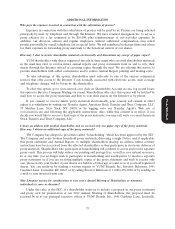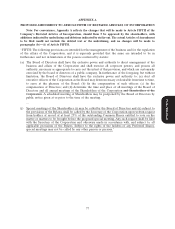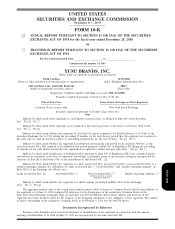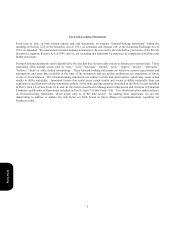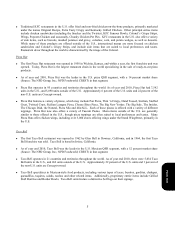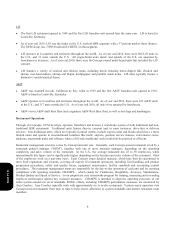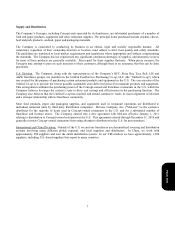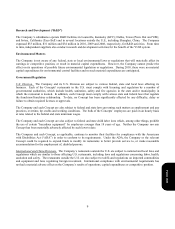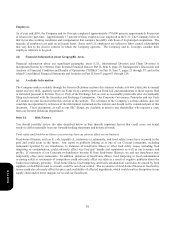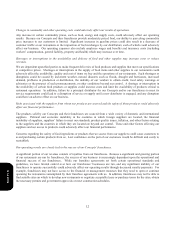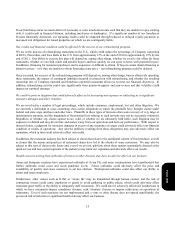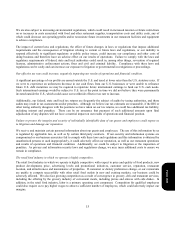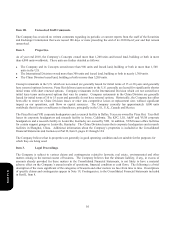Pizza Hut 2010 Annual Report Download - page 103
Download and view the complete annual report
Please find page 103 of the 2010 Pizza Hut annual report below. You can navigate through the pages in the report by either clicking on the pages listed below, or by using the keyword search tool below to find specific information within the annual report.
6
LJS
• The first LJS restaurant opened in 1969 and the first LJS franchise unit opened later the same year. LJS is based in
Louisville, Kentucky.
• As of year end 2010, LJS was the leader in the U.S. seafood QSR segment, with a 37 percent market share (Source:
The NPD Group, Inc.; NPD Foodworld; CREST) in that segment.
• LJS operates in 4 countries and territories throughout the world. As of year end 2010, there were 964 LJS units in
the U.S., and 31 units outside the U.S. All single-brand units inside and outside of the U.S. are operated by
franchisees or licensees. As of year end 2010, there were 86 Concept-owned multi-brand units that included the LJS
concept.
• LJS features a variety of seafood and chicken items, including meals featuring batter-dipped fish, chicken and
shrimp, non-fried salmon, shrimp and tilapia, hushpuppies and portable snack items. LJS units typically feature a
distinctive seaside/nautical theme.
A&W
• A&W was founded in Lodi, California by Roy Allen in 1919 and the first A&W franchise unit opened in 1925.
A&W is based in Louisville, Kentucky.
• A&W operates in 9 countries and territories throughout the world. As of year end 2010, there were 322 A&W units
in the U.S., and 317 units outside the U.S. As of year end 2010, all units were operated by franchisees.
• A&W serves A&W draft Root Beer and a signature A&W Root Beer float, as well as hot dogs and hamburgers.
Restaurant Operations
Through its Concepts, YUM develops, operates, franchises and licenses a worldwide system of both traditional and non-
traditional QSR restaurants. Traditional units feature dine-in, carryout and, in some instances, drive-thru or delivery
services. Non-traditional units, which are typically licensed outlets, include express units and kiosks which have a more
limited menu and operate in non-traditional locations like malls, airports, gasoline service stations, convenience stores,
stadiums, amusement parks and colleges, where a full-scale traditional outlet would not be practical or efficient.
Restaurant management structure varies by Concept and unit size. Generally, each Concept-owned restaurant is led by a
restaurant general manager (“RGM”), together with one or more assistant managers, depending on the operating
complexity and sales volume of the restaurant. In the U.S., the average restaurant has 25 to 30 employees, while
internationally this figure can be significantly higher depending on the location and sales volume of the restaurant. Most
of the employees work on a part-time basis. Each Concept issues detailed manuals, which may then be customized to
meet local regulations and customs, covering all aspects of restaurant operations, including food handling and product
preparation procedures, safety and quality issues, equipment maintenance, facility standards and accounting control
procedures. The restaurant management teams are responsible for the day-to-day operation of each unit and for ensuring
compliance with operating standards. CHAMPS – which stands for Cleanliness, Hospitality, Accuracy, Maintenance,
Product Quality and Speed of Service – is our proprietary core systemwide program for training, measuring and rewarding
employee performance against key customer measures. CHAMPS is intended to align the operating processes of our
entire system around one set of standards. RGMs’ efforts, including CHAMPS performance measures, are monitored by
Area Coaches. Area Coaches typically work with approximately six to twelve restaurants. Various senior operators visit
Concept-owned restaurants from time to time to help ensure adherence to system standards and mentor restaurant team
members.
Form 10-K



